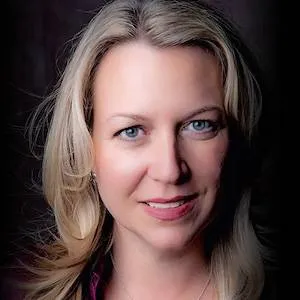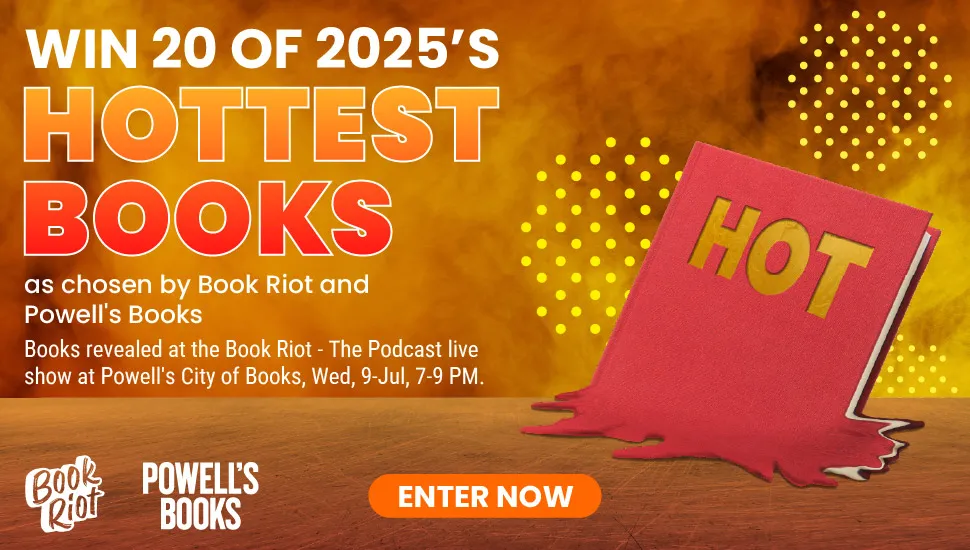
Rising to the Occasion of Our Own Lives: An Interview with Cheryl Strayed
This content contains affiliate links. When you buy through these links, we may earn an affiliate commission.
Bestselling author Cheryl Strayed’s newest book Brave Enough, a collection of quotes, recently hit the shelves, and I was lucky enough to get an interview! We spoke about her books, women and writing, and more; our conversation (edited for clarity/length) follows.
Jenn Northington: First I want to say how beautiful Brave Enough is, both in look as well as in words. I was wondering if you got to participate in or observe the design process as it went along?
Cheryl Strayed: Thank you! I agree. It’s the one part of your book that you get to, like, totally openly brag about. And I keep realizing that sometimes people think I’m talking about the content when I go, “Oh my God, it’s such a beautiful book!” But I mean it from a physical standpoint; it turned out really cool, and that’s what I was hoping for. Because you know obviously, the point of a book of quotes is, [it’s] a book that you want it to feel good in your hands and to look good on your table, it’s a book you pick up several times instead of reading it necessarily front to back. It was really tricky to come up with the cover and design. When we finally came down to the design of the cover — and I knew it was going to be this really cool clothbound with the debossed title and everything — we could not decide on the color, because we knew that the text was going to be gold but it looks so beautiful in so many different colors. There was red, and there was purple, and there was blue. Honestly, we looked at dozens. And finally I was like, “I can’t decide, I can’t decide.” So they did mock-ups of what the cover would actually look like, and sent me about six of them. I lined them up on my dining room [table] and left them there for a week, and would just walk past and be like, “Which one do I like today?” And they left the decision up to me in the end, which was so cool. I got to choose the color. The green, it wasn’t my first pick, but then it grew on me and I went with it and I’m so glad I did. And that ribbon, I never in my wildest dreams thought I’d have a book that has a ribbon.
JN: Yeah, I love the ribbon! It’s such a nice touch.
CS: The book looks like a little jewel, doesn’t it?
JN: It looks like it’s almost been wrapped for you, like, “Here is a present for you.”
CS: Yes. So it’s all the designers, but I weighed in on the cover and the color. The designers did a great job.
JN: I don’t know how they even start to think about picking font and sizing and layout of the quotes, but it’s a beautiful beautiful book.
CS: Thank you!
In the end we are responsible for rising to the occasion of our own lives.JN: How did you pick the first and the last quotes? CS: Oh, that’s a great question. How I picked all the quotes was definitely crowd-sourcing. I wasn’t concerned with what I thought was the wisest or whatever, it was more like, what do people, what do readers really grab and what’s meaningful to them. And I saw that “Be brave enough to break your own heart” was really a very popular one. It was one that I think a lot of people have taken into their lives in a way that was helping them through that hard decision that they had to make. Knowing that we all sometimes have to make a decision that involves causing ourselves sorrow and suffering, but that we’re doing it for a greater purpose, a higher purpose that will serve us well down the road. So I knew that because that was such a popular quote, that I wanted in some ways to highlight it, and of course then it also led me to choose the title from that quote. I thought it should be there, front and center. It just made sense in some ways to use that first page to be — and now as I’m talking about it, that is the first quote in the book, right? JN: Yeah! It is. CS: Okay. And then the last quote — I don’t have the book in front of me, so the last quote is “The fuck is your life. Answer it.” Right? JN: Yes, that’s right. CS: In some ways that quote seems to me to be a call, to say, “Ok, so here are all these things, all these different words about any number of subjects, and in the end we are responsible for rising to the occasion of our own lives.” It just seemed like a nice send-off, if you will. JN: It feels that way when you’re going through the book. CS: When you read it, did you sit down and go front to back? JN: I read the first quarter all at once and then, was like, I’m going to take a break now, because I was having a lot of feelings. And then I — I confess to picking through, and jumping around and reading what caught my eye font-wise for a while, which was also a really interesting experience. But then, the first and the last are there no matter how you start or end. CS: Yeah, obviously some people will sit down and read it front to back, but I do think it’s a book that you dip into. The book is so solid, and the paper is so fine, there’s this part of me that — I have this image in my head of people ripping out pages of the book, and tacking them to their bulletin boards. I mean there could have been a good argument made to be, like, “Let’s make it a spiral bound notebook and you rip out the pages,” because certainly in my life that’s how quotes function. Let’s put this up on the wall, you know? So I can read it over and over. JN: I’m kind of amazed you guys haven’t announced the Cheryl Strayed Quote of the Day Calendar yet. CS: That’s probably next year, right? JN: We’ll look forward to that! CS: I’m teasing! That’s an idea, that’s an idea. JN: Certainly if you go looking on the internet there are enough [quotes] that people have found meaningful, so I feel like that could come together. Speaking of reading it periodically and dipping in and out, I actually have that experience with Tiny Beautiful Things. I didn’t read that one all in a row. I kind of leafed through and cherry-picked. I wonder how common that is, though. CS: I think it’s common, though I will say, one of the experiences that people report to me a lot with Tiny Beautiful Things is that they’ll sometimes read a letter that they’re like, “Oh well, this letter doesn’t really apply to me,” and then they read my answer and it totally applies to them, you know? So I think when you cherry-pick Tiny Beautiful Things you might be sometimes missing things that are actually really relevant to you. But I know what you mean, it would make sense that you would go through and be like, “Let’s see, let’s find letters by people who have problems like my own,” or the opposite, “So totally not like mine that I won’t end up weeping on the train.” I think that there’s no right way to read any book. And certainly when it’s a collection I do the same kind of thing, I dip in and out. JN: I’ve definitely read all of them over the course of owning the book, but when I first sat down to read it I was like, “I’m going to shuffle it up a bit.” I don’t know why though. I’m also a person who shuffles songs on albums, which other people tell me is sacrilege, so maybe it’s a media consumption habit? CS: I’m just glad that you listen to whole albums. It used to be, that was the only way you could listen to songs and now I find myself just cherry-picking specific songs rather than having whole albums, which is kind of sad, it’s kind of a loss JN: It’s interesting; I understand of course that artists have a vision. Like you had a vision when you put together the quotes and musicians have a vision when they put together their songs, but readers come to the work or listeners come to the work and they bring their own needs to it. But I do get stuck. I read all of the pieces in Tiny Beautiful Things, I just read them out of order. I’ll listen to an album for a week straight, but I listen to it on shuffle. Because then I feel like I notice something different every time I listen to it.
The way we transfer, essentially, authority from the writers to the readers is very cool to me.CS: When I was ordering Brave Enough and Tiny Beautiful Things, in both cases, I did spend a lot of time thinking, “What order should these be in,” but part of that was also just acknowledging that, some of it is, you just have to put it somewhere. Some of the pieces speak to each other and so you put them together, but sometimes it was just, well, let’s just plunk this one here and that one there and call it a day. It’s not always, “Oh my god, you’re not having some experience I intended you to have if you read it out of order.” And here again, how Brave Enough was even born, was just the way that readers make the book you wrote theirs. They’re the ones that get, in the end, to say what it means and what affect it has, if any. Most of the quotes in Brave Enough, it wouldn’t have really occurred to me, “Oh my gosh, that’s a quote.” It was just that other people pointed it out and used it as one. The last line of Wild, “How wild it was, to let it be.” I would have never guessed that people would really quote that, and so many people have tattoos of that line. What’s fascinating to me about that is, it’s not about me and my book, it’s about them and their life. Which is so beautiful. It’s this thing that I wrote in my book about my life, but then other people make it theirs to the point that they put it on their body. Permanently. The way we transfer, essentially, authority from the writers to the readers is very cool to me. JN: It is, it’s really cool to watch. Another thing I feel like I’m seeing is an uprising in books by women that are about creativity or emotional development or memoir. So there’s your work, there’s Big Magic by Elizabeth Gilbert, there’s Brené Brown, and Shonda Rhimes’s Year of Yes. I’m wondering if you feel like we’re having a moment.
Finally, women writers are just saying, “We’re not going to let you call us small anymore, because it’s gigantic.”CS: Maybe! I think we are, now that you mention it. And I think what that’s about is, for so long — and obviously this is still a really predominant idea — but I just can’t begin to tell you how many times I’ve heard my work and the work of other women writers talked about in these ways that are like, “She writes about the *intimate*, but not about socially significant things.” And I think so many women writers and also readers of both genders, and I’ll even say some male writers too probably, are redefining what we think of as socially significant. I can tell you, being on the other side of literally thousands upon thousands of people feel that their lives have been changed by one of my books. And I know that people feel that way about books by Lydia Yuknavitch and Roxane Gay and Elizabeth Gilbert, and I could go on and on with that list. I think, ok, well if that’s not socially significant, I don’t know what the fuck is. The reasons that their lives feel changed is that we wrote about a very intimate inner landscape and told the truth about it. Whether that be about a fictional character or a nonfictional character. I think that finally, women writers are just saying, “We’re not going to let you call us small anymore, because it’s gigantic.” Just take, for example, Eat Pray Love, the number of people who say they feel changed by that. There are so many people who really are taking art personally and making change in their lives because of it, and there’s nothing small about that. That’s a big gigantic thing. So yes, I think we are in a moment. JN: I think it’s a moment that’s maybe been coming on for a few years, but it seems to me that it’s really peaking, or becoming more obvious. Eat Pray Love is such a good example, because when I was in the bookstore handselling that book, back when it first came out, it was so dismissed as, “Oh, it’s commercial.” “Oh, it’s for book clubs.” “Oh it’s for moms,” despite its popularity. And I feel like we’ve gotten to a point where maybe, things are less easily dismissed that are stories just like that. CS: I think it’s so funny when it’s like, “Oh, it’s just for moms,” as if moms are this uniform, idiotic, imaginary group of people. And just for the record, Liz Gilbert is not a mom, kind of famously. But I know, it’s shorthand for basically women, stupid women. The degree to which I think all of that thinking is bullshit cannot be overstated. Lots of people have come to me and said, “I didn’t read Wild because it was on the bestseller list, but then I broke down and read it and I absolutely loved it.” And I always say to them, “I hope that that means that now you’ll question whatever your biases were about books that get on the bestseller list.” And especially books that get on the bestseller list by women. I don’t think anyone goes to Jonathan Franzen and says “I didn’t read The Corrections because it was such a blockbuster bestseller.” You know what I mean? This is a discrete coded way that we talk in sexist terms without even knowing that we’re being overtly sexist. And that works too with race. There’s so much of that at this point that’s happening, and it’s really almost in code, these subliminal ways that we talk about race and gender when it comes to our literature. And equating popular with not-high art, not-literary, especially then those books are by women. I do think that we’re evolving, but there is still that dynamic to be sure. JN: Yeah, there’s miles to go before we sleep, I think. But it does feel like, from my perspective, that we’re making progress. CS: Indeed.
I think of literature really as my religion. It is my sacred place. It’s my anchor.JN: Obviously your words have meant a lot to a lot of readers. I’m wondering what book you turn to when you need a comfort read or inspiration. CS: So many! So many books. Once of the most fascinating aspects that we haven’t directly touched on but I think that we’re kind of talking about is, there is this way in which some of these books, like Tiny Beautiful Things, for example — it’s a literary book of essays. It really is. And yet it’s in the self-help category, a category that — I myself have felt skeptical of that genre, sort of snobby in some about it. “But these are essays!” But it’s also self-help. One of the things that I’m struck by is that, when somebody comes up to me and says “Your book saved my life,” I never know which book they’re talking about. Because people also say that about Torch, my first novel, and they have been saying it for years. Even though neither of those books [Torch or Wild] are in the self-help category, one’s a novel and one’s a memoir, they function in a lot of people’s actual lives in a way that sounds like self-help. The way that people talk to me about Torch and Wild is the same way that people talk to me about Tiny Beautiful Things and Brave Enough, even though those latter two books are in this other category. And I think that’s true of some of these other writers we’re talking about. For example, I mentioned Lydia Yuknavitch. Her memoir, The Chronology of Water, is a completely literary memoir, and utterly, utterly life-changing in that way that self-help literature can be. I think that people read it as a deep reflection of who they are. When you ask me, “What books do you turn to for consolation,” there are so many books over the course of my life. Pretty much, that’s what books do to me. They are my friends and consolers. I wrote about that in Wild, you know, Adrienne Rich’s The Dream of a Common Language. The first thing I did this morning actually, I was in bed, I woke up and I was remembering this poem by Adrienne Rich called “Dialogue,” and I grabbed my phone which was on my nightstand and I googled it and found it and read it. And that was the first thing I did this morning. And I’ve read that poem intermittently over the last 25 years. So I turn to that, I turn to Alice Munro, my favorite writer. Sometimes it’s not even an intentional thing. Sometimes it’s just wandering the shelves. So many rooms of my house are lined with books and [I’ll just be] grabbing a book and reading it, reading a page, or a paragraph, and feeling that sense of being connected to other people across race and gender and generation and culture. That is so deeply, profoundly consoling to me. I think of literature really as my religion. It is my sacred place. It’s my anchor. JN: I feel very similarly. I have books that I’ve read over and over again … and it does, it feels a little bit like going to church. CS: Isn’t it amazing?
The main thing that people say about my work is that they’re weeping. Which I love, don’t get me wrong, I love making people cry.JN: It is. Well, you mentioned Torch. So you’ve written a novel, you’ve written a memoir, you’ve written essays-slash-self help, depending on who’s shelving it. Is there a genre you are dying to dive into as a writer? CS: Let’s see, gosh. I’m also writing a script, a TV script for HBO, and that’s a whole different kind of writing. But in the book realm — I love poetry, but I’m gonna give the world a big solid and I’m going to keep myself from writing my own collection of poems. I’m just going to stay on the sidelines, you know, the very verbose prose writer that I am. There’s two areas that I’d like to branch into. One is tapping into something that was so interesting to me as a writer when I was writing the Dear Sugar column: the epistolary exchange. What you were reading when you read those is actually a letter that someone wrote to me and a letter that I wrote back to someone. Obviously that was done in a public space, so I was really writing to more than just the person who received the letter. But I was always writing to that person too, foremost. So it has occurred to me to write an epistolary novel. A novel that is done entirely in letters could be really interesting. I’m not working on that right now, but it comes into my mind that that could be potent ground for me. I always feel like I’m funnier in real life than I am on the page, because my work — it can be funny in places, absolutely, but the main thing that people say about my work is that they’re weeping. Which I love, don’t get me wrong, I love making people cry. But I have thought about writing a collection of funny things. One of the running jokes that I have with my husband is that in the world, I’m Sugar, and everyone’s like, “Oh, you’re so nurturing and kind and you love everyone unconditionally.” Then in my real life my husband and kids see a more multi-dimensional side of me which is like, you know, this person who is complaining about things and is grumpy. I would rant about people and things to my husband, and I hatched this idea for a funny book. I arrived at the title, it’s called Guess What, Dumbass and it’s a collection of things that I’m furious about and want to rant about, these short essays of me ranting against this or that category of people. JN: That sounds amazing! CS: What do you think? JN: I would read it! I would read it. CS: It would be new territory for me! JN: I really appreciated the introduction to Brave Enough, and one of the things that was so funny was your husband putting the quote on the fridge, the “I’m going to be mad at you for the rest of my life.” It’s so interesting to have that window, because you are known for being accepting, and unconditional, and supportive, but of course, you’re a person. CS: That’s right, that’s right. JN: Ok, my last question: what are you reading right now? CS: I just finished reading a wonderful book that I hope lots of people will read. It’s called Becoming Nicole. It’s a nonfiction book by Amy Ellis Nutt. It’s about a family who live in Maine, and the parents adopted identical twin boys as infants. As the boys were growing up, very early on, one of the boys just knew that he was not a boy. That he was a girl. And the family had to really figure this out. What would they do? They came to a slow understanding that their son was transgender and was really a girl, and they helped him in all kinds of ways with this, and he became Nicole. The book follows them through their struggles and trajectory, and it was really illuminating to me and also just a fascinating story.












